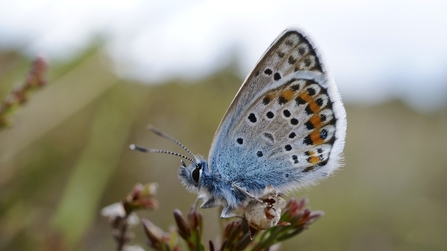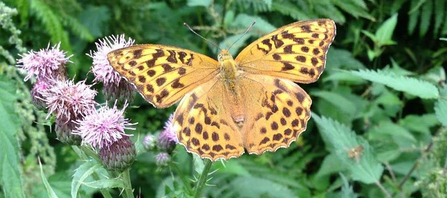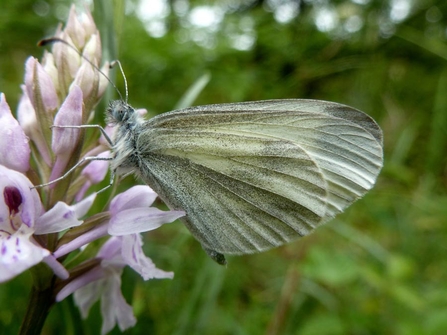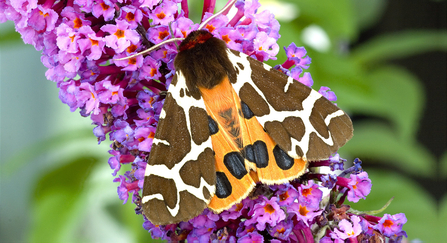Butterflies to look out for this month include garden favourites such as red admirals and small tortoiseshells, the second flight of commas, and later in the month, holly blues. Some scarcer species will be flying too, and it’s worth making a special trip to find them. Prees Heath Common is my first choice – July is the month to see silver-studded blues in flight, and they make a marvellous spectacle on a calm, sunny day.
Cath's Nature Notes - July
Elephant hawk-moth caterpillar ©Dawn Monrose

Remind yourself that this is the only place you can see them anywhere in the Midlands, and appreciate the special conservation efforts behind the survival and increase of the colony. Llynclys and Llanymynech are worth a special trip too. It’s probably a bit late for pearl-bordered fritillaries, but the last of the small pearl-bordered fritillaries might still be around.

Patricia Astill
Dark green and silver washed fritillaries (pictured) are at their peak though, and there’s the possibility of white letter hairstreak too. Small and large skippers will be zooming through the grasses, but the grizzled skippers are over for the year.

Mike Williams
For woodland butterflies, Bury Ditches near Clun is a prime site. In July it should be possible to see wood whites and purple hairstreaks. Watch out for the feeble, fluttering flight of the wood white along forest rides. For purple hairstreaks you really need binoculars and the patience to watch the tops of oak trees in the early evening, but I’ve been lucky enough to catch one on a rare excursion to ground level below an oak.

Denis Jackson
I have to admit that I’m no expert on moths. I like them a lot, and some of them have the most fantastic names – buttoned snout? setaceous hebrew character? - but I can’t identify that many. This year I’m going to try a bit harder. You don’t really need a fancy moth trap (though I admit it’s tempting!); a bright light shining on a hanging white sheet should attract plenty, and if the sheet continues flat on the ground the fallen moths can be gently picked up for a closer look. There are lots of day-flying moths too, some of them every bit as bright and beautiful as the butterflies – burnet moths, cinnabars and garden tigers, all perfect little gems.
The larger dragonflies will be emerging from their aquatic larval state, and unlike the smaller damselflies, can be seen well away from water as they hunt for insect prey. The best place to see them, though, is in wet places. Look out for chasers and skimmers this month. Catherton Common and Cramer Gutter are a good destination for dragonfly spotters this month, as keeled skimmers and the spectacular golden-ringed dragonflies – the longest dragonfly in the UK - can be found around the acidic pools in which they breed. Fenn's and Whixall Mosses are the place to see white-faced darters, and also black darters – our smallest dragonfly. Emerald damselflies are another ‘bog specialist’, emerging now.
If insects aren’t your thing, why not search out some of the later orchids? Pyramidal and bee orchids flower at Llanymynech Rocks, whilst at nearby Llynclys Common you might find night-scented greater and lesser butterfly orchids, clove-scented common twayblade and elusive frog orchids. Even if you don’t find them, it’s a lovely place to spend a sunny day! Take a picnic and make the most of it.
My final celebrities for July are the swifts and hirundines. Swallows and house martins are making full use of the long days collecting insects over wetlands and pastures to feed their broods. Swifts race in ‘screaming parties’ through town streets in the evenings like boy-racers, here for such a short time but truly the sound of summer. This year the Wildlife Trusts and the Royal Horticultural Society’s Wild About Gardens campaign is encouraging us all to plant insect-friendly borders and bog gardens to produce food for summer’s high fliers, so why not download the booklet and have a go? You might curse the ‘bugs’ when you’re sitting outside on a warm evening with a long drink, but without them, you wouldn’t have the glorious soundtrack of those racing swifts!


